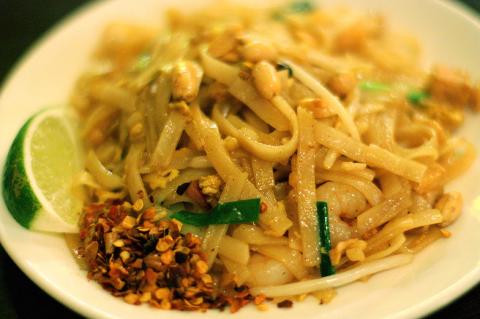Located near Zhongxiao Dunhua MRT Station (忠孝敦化捷運站), Lacuz Thai Fusion Cuisine offers an enticing proposition — Thai food that costs just NT$450 to order an all-you-can-eat selection from 65 options. (You can also pay NT$390 to select from a 38 item menu.) The array of dishes offered is extremely broad and the quality varies widely, but when the food is good, it is very good.
At Lacuz, you order from a menu instead of serving yourself from a buffet, which prevents the chaotic crowds and feeding trough atmosphere seen at many all-you-can-eat restaurants while allowing you to choose the spiciness of your dishes. The restaurant’s busy servers are attentive once you flag them down, but the best thing to do is to get as many dishes as possible in your first round of ordering; otherwise, you might be in for a long wait. Each plate is very small, which allows you to sample many flavors without leaving uncomfortably bloated.
First off, the dishes you can skip to save space in your stomach for worthier options. The pineapple fried rice could not decide if it wanted to be an entree or dessert. In addition to chunks of the fruit and the cashew nuts usually found in the dish, Lacuz’s version also included a lot of raisins and very sweet rousong (肉鬆), or dried pork floss. All it needed was some coconut milk to turn it into a pudding.

Photo: Catherine Shu, Taipei Times
(Raisins seem to be a signature Lacuz vice. On a recent visit to Lacuz’s sit-down restaurant in the Bellavita shopping mall, my friend and I also had to pick tonnes of the dried fruit out of an otherwise excellent fried rice).
The best part of the deep-fried shrimp cake was its sweet and sour dipping sauce. The shrimp cake itself was not served hot and did not taste freshly made. Our deep-fried chicken in curry sauce was fine, but the curry was bland and not spicy at all.
Lacuz’s must-order dishes include the steamed sea bass, which was served whole on a small chaffing dish. Cooked in a fantastic lime and garlic sauce, the mellow-tasting meat was tender and easy to slip off the bone. The deep-fried shrimp rolls are served in a few tiny pieces to an order, but they are so packed with flavor in their crispy skins that just a few bites is enough.

Photo: Catherine Shu, Taipei Times
The small portion of papaya salad was a refreshing counterpoint to our more flavorful, oilier entrees, while our other cold dishes, like the century egg salad (just a couple of slices of egg topped with a sweet and sour sauce) and raw prawns with chopped raw garlic and chili, were also good.
Lacuz’s pad Thai (called stir-fried kway tewo Thai style on the restaurant’s English menu) is plated in an unappealing lump, but the firm rice noodles were the right texture and the lime juice and chili sauce were delicious. A refreshing tom yum shrimp soup was a good final dish and our dessert, included in the all-you-can-eat price, was a little bowl of black pudding rice with coconut milk.
The reason for Lacuz’s 10 percent service charge is a bit of a mystery, considering that the servers only showed up at our table after we vigorously flagged them down. We were served the wrong dish two times during our dinner. On the other hand, all of our small plates arrived quickly and our waiters, when we did see them, were very easygoing as they patiently helped us navigate the huge menu.

Oct. 27 to Nov. 2 Over a breakfast of soymilk and fried dough costing less than NT$400, seven officials and engineers agreed on a NT$400 million plan — unaware that it would mark the beginning of Taiwan’s semiconductor empire. It was a cold February morning in 1974. Gathered at the unassuming shop were Economics minister Sun Yun-hsuan (孫運璿), director-general of Transportation and Communications Kao Yu-shu (高玉樹), Industrial Technology Research Institute (ITRI) president Wang Chao-chen (王兆振), Telecommunications Laboratories director Kang Pao-huang (康寶煌), Executive Yuan secretary-general Fei Hua (費驊), director-general of Telecommunications Fang Hsien-chi (方賢齊) and Radio Corporation of America (RCA) Laboratories director Pan

The classic warmth of a good old-fashioned izakaya beckons you in, all cozy nooks and dark wood finishes, as tables order a third round and waiters sling tapas-sized bites and assorted — sometimes unidentifiable — skewered meats. But there’s a romantic hush about this Ximending (西門町) hotspot, with cocktails savored, plating elegant and never rushed and daters and diners lit by candlelight and chandelier. Each chair is mismatched and the assorted tables appear to be the fanciest picks from a nearby flea market. A naked sewing mannequin stands in a dimly lit corner, adorned with antique mirrors and draped foliage
The consensus on the Chinese Nationalist Party (KMT) chair race is that Cheng Li-wun (鄭麗文) ran a populist, ideological back-to-basics campaign and soundly defeated former Taipei mayor Hau Lung-bin (郝龍斌), the candidate backed by the big institutional players. Cheng tapped into a wave of popular enthusiasm within the KMT, while the institutional players’ get-out-the-vote abilities fell flat, suggesting their power has weakened significantly. Yet, a closer look at the race paints a more complicated picture, raising questions about some analysts’ conclusions, including my own. TURNOUT Here is a surprising statistic: Turnout was 130,678, or 39.46 percent of the 331,145 eligible party

The election of Cheng Li-wun (鄭麗文) as chair of the Chinese Nationalist Party (KMT) marked a triumphant return of pride in the “Chinese” in the party name. Cheng wants Taiwanese to be proud to call themselves Chinese again. The unambiguous winner was a return to the KMT ideology that formed in the early 2000s under then chairman Lien Chan (連戰) and president Ma Ying-jeou (馬英九) put into practice as far as he could, until ultimately thwarted by hundreds of thousands of protestors thronging the streets in what became known as the Sunflower movement in 2014. Cheng is an unambiguous Chinese ethnonationalist,